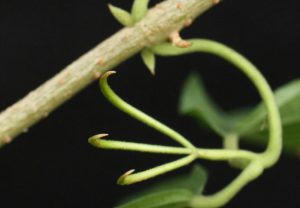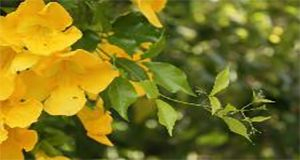Some invasive plants can radically alter landscapes making them look like monocultures, alien, or evenrelatively ugly. In South Florida, Brazilian pepper and old-world climbing fern come to mind. However, there are exceptions. The cat’s-claw vine (Dolichandra unguis-cati) has beautiful flowers that often shower the canopies of supporting trees and structures this time of year. It is a true harbinger of spring in the coastal regions of the Southeastern U.S. – an

area that often only has subtle horticultural cues to infer a sense of seasonality. However, this species is an aggressive spreader and invasive species that is better left admired in its native environment. Originally from tropical dry forests in the Caribbean and Central and South America, this vine can put a strangle-hold on both maintained landscapes and natural areas without human intervention. The flowers, although beautiful, often do not persist beyond a short window of weeks in late March through April.
Above: The psedustipule or "claw" from which this plant gets its name.
Credit: Niels Proctor, UF/IFAS
 Left: A member of bignonicaeae (e.g., like tabebuias and jacaranda) the flower of this vine is stunning… just don’t let it distract from its invasive status. Credit: John Roberts, UF/IFAS
Left: A member of bignonicaeae (e.g., like tabebuias and jacaranda) the flower of this vine is stunning… just don’t let it distract from its invasive status. Credit: John Roberts, UF/IFAS
If this plant is on your landscape, it’s probably a good idea to remove it. Your other plants will thank you for the freed-up sunlight. Hand pulling of young vines is suggested and established individuals can be killed by cutting at the base of the vine. However, these plants typically have fuel reserves for future growth (i.e., belowground tubers), so treating the exposed vascular tissue after they have been cut with a glyphosate is also suggested.
 OTHER LANGUAGES
OTHER LANGUAGES
 OTHER LANGUAGES
OTHER LANGUAGES